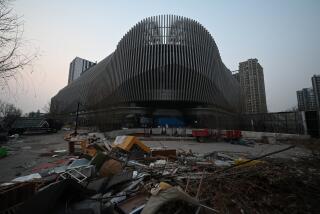Resortâs Cloudy Prospects Reflect Japanâs Bank Woes
ABUTA, Japan â The Apex Resort Toya, which juts like Hearst Castle from a secluded mountaintop, is a $500-million white elephant, a symbol of the pain yet to come as Japan struggles to clean up its monumental bad-loan problems.
The huge loan to the splendid resort--which essentially operated for five years without paying interest or principal on its debt--helped set off a downward spiral that dragged the local economy on the northern island of Hokkaido into a deep funk.
The issuing bank, Hokkaido Takushoku Bank, collapsed in November under a mountain of bad loans. Its demise exposed how dependent the local economy had been on the bank: The resort went under, dozens more cash-starved businesses folded, and thousands of workers lost their jobs.
âItâs as though the bomb was dropped on Hokkaido,â said Eichi Murakami, chief of research at Tokyo Shoko Research Co.âs Hokkaido arm. âAnd we havenât hit bottom yet.â
The Hokkaido experience helps explain Japanâs reluctance to let the free market have its way with the nationâs many weak banks, as the United States and others are demanding. Other communities can expect the same fate as Hokkaido in the event of widespread bank failures.
U.S. officials are prodding the country to clean up its banking mess, write off bad loans that probably exceed $600 billion and let market forces prevail. But in the short term, taking a hard-line approach may cause the worldâs second-largest economy to slip even deeper into recession, further weakening the yen and destabilizing the rest of Asia.
Although the U.S. recently intervened, buying yen for dollars in an attempt to shore up Japanâs currency, the yen lost ground every day last week and closed at 141.69 to the dollar Monday in New York. Many analysts expect the yen to continue its plunge.
Deputy U.S. Treasury Secretary Lawrence Summers, who parachuted into Tokyo to huddle with Japanese officials at a hastily arranged mid-June summit, argues otherwise. Attacking the banking morass head-on, he asserts, would mean growth, not unemployment, and would thus strengthen the yen.
*
Japanese officials seek a softer landing. âIf we let all the banks collapse, then the situation will be far worse,â said an official at Japanâs central bank.
Just Friday, the government apparently agreed to help rescue the Long-Term Credit Bank of Japan by subsidizing its takeover by Sumitomo Trust & Banking, averting what might otherwise have been Japanâs largest corporate failure since World War II.
Nevertheless, the Japanese government says a serious nationwide credit crunch has frozen even healthy businesses out of loans they need to cover operating costs as banks nationwide comply with stricter reserve and capital-adequacy requirements and impose greater scrutiny on new loans. The weaker the yen, the worse the problem; a strong dollar inflates the yen value of the banksâ overseas assets, hiking the amount of capital they are required to have on hand.
The government is expected to announce this week a plan for a government-operated âbridge bankâ to tide over healthier borrowers. (Bank deposits are insured by the government through 2001.) But few details have been disclosed about how such a bank would work or of criteria for the government loans.
No one can say precisely how much in bad loans Japanâs financial institutions carry, and thatâs part of the problem. The major banks have disclosed loans of about $86 billion so bad they are likely to be sold or written off by a sort of government collection agency. An additional $464 billion of loans, however, warrant further review; that hazy, so-called second category of loans includes both healthy and weak borrowers, the banks say. Borrowers in this enormous âgray zoneâ are the ones in the most danger.
âSome of the companies could recover if properly funded,â said a government official. Citing the credit crunch caused by the collapse of Hokkaido Takushoku, which is known in Japan as Takugin, the official said, âWe donât want to repeat that experience.â
Of course, many think that if banks turn down customers, then market mechanisms are working exactly as they should. âA credit crunch means companies who shouldnât get credit wonât,â argued Alicia Ogawa, a banking analyst for Salomon Smith Barney in Tokyo.
But letting the companies fail has its price, as Hokkaidoâs experience shows. Because Japanâs capital markets are poorly developed, most businesses depend on banks for financing. And like everything else in Japan, much of the banking business is based on long-cultivated, exclusive relationships. New alliances take time to forge.
Meanwhile, financial pressures are growing. Consumption in Japan has withered as worried homemakers tighten purse strings. The nation officially went into recession in the first quarter, contracting at an annual rate of 5.3%. Investment is drying up, and unemployment has hit a record postwar high of 4.2% nationwide.
If Japan grows at less than 1% this year, said Haruo Shimada, economics professor at Keio University, many of the borderline loans will assuredly turn sour.
Hokkaido has been particularly hard-hit. In April, bankruptcies soared 42% in Hokkaido compared with the year earlier, while those in the rest of Japan rose 1.2%, local development officials say. Since the November bank collapse, the liabilities of the bankrupt companies have tripled. The statistics actually understate the problem: For instance, the failed bank itself isnât listed as a bankruptcy because it is being absorbed, government officials say.
Now, Hokuyo Bank, the smaller bank that is taking over the failed bankâs Hokkaido operations, holds in its hands the fate of many former Takugin borrowers, including a major department store and several prominent contractors, Hokkaido development officials say. Takugin had about $4.64 billion of questionable loans on Hokkaido. (An additional $8.57 billion of even worse loans will probably be written or sold off to the government.)
Hokuyo, which says it expects to get about $200 million of public funds to assist in the bailout, faces a dilemma: If it takes on too many marginal loans, it will become sickly too. Town officials in Abuta donât have much hope that anyone will buy the mothballed Apex Resort, which has been for sale since it closed in March. Operating the sprawling facility profitably would be difficult even if the property came free--$20 million annually for upkeep. Just clearing the snow in the long winters costs $100,000.
Indeed, the resortâs high overhead illustrates a major problem with many of Japanâs bank loans, which have been issued based on the collateral property values (which have plunged), rather than analysis of the businessesâ prospects.
The resort was originally planned during the late 1980s, when Japanâs economy was soaring. But when the economy tanked in the early 1990s, the resort made no adjustments in its scale.
*
When it opened in 1993 after borrowing $444 million from Takugin, the resort had drawn only half the members it expected, said attorney Motohiro Asano, who now represents Apex against creditors.
And the bank threw good money after bad. In a practice known in Japan as jitensha sogyo, or âbicycle operations,â it recycled interest âpaymentsâ back to the resort to cover operating costs, attorney Asano said. By the time it went under, the resort owed an additional $90 million.
A Takugin spokesman said it is normal in Japan to wait 10 to 20 years for a hotel to become profitable. âLocal businesspeople were expecting the area to become a big resort, and a large amount of money was invested,â a Takugin spokesman said. âSo we didnât want to give up.â
The resortâs mountaintop site was chosen for its views of both the craggy Pacific Ocean coast and of a scenic lake bordered by a volcano that resembles Mt. Fuji. The only problem is, clouds often settle like a mushroom cap over the mountaintop, obscuring the views.
âFrom the beginning, it has seemed destined to go bankrupt,â said Abuta resident Akira Ohta, who bemoaned that taxpayers will probably end up footing the bill. âItâs foggy one-third of the time, so what can they see? Doesnât that say it all?â
*
Etsuko Kawase of The Timesâ Tokyo Bureau contributed to this report.
More to Read
Sign up for Essential California
The most important California stories and recommendations in your inbox every morning.
You may occasionally receive promotional content from the Los Angeles Times.










